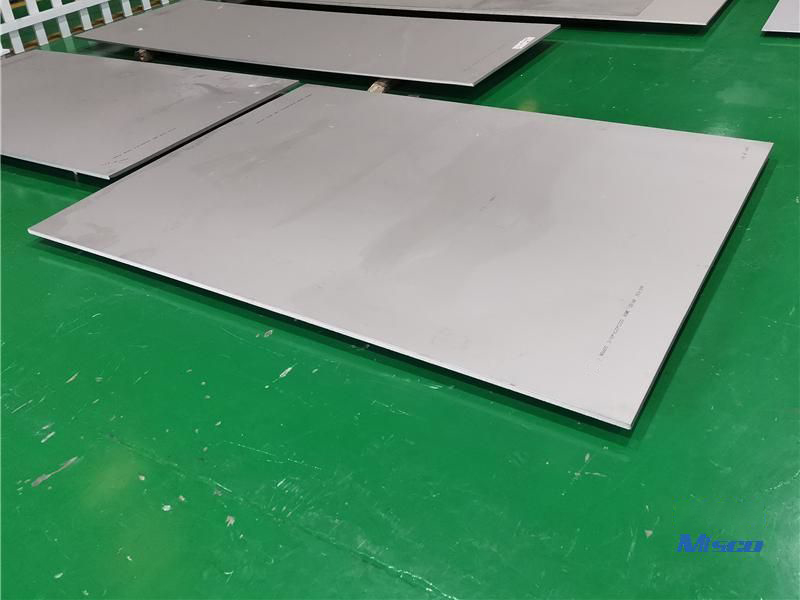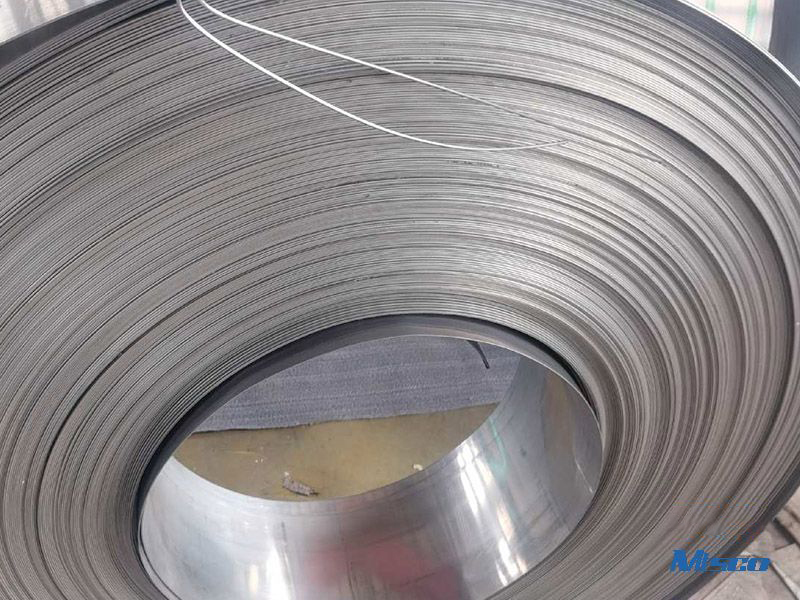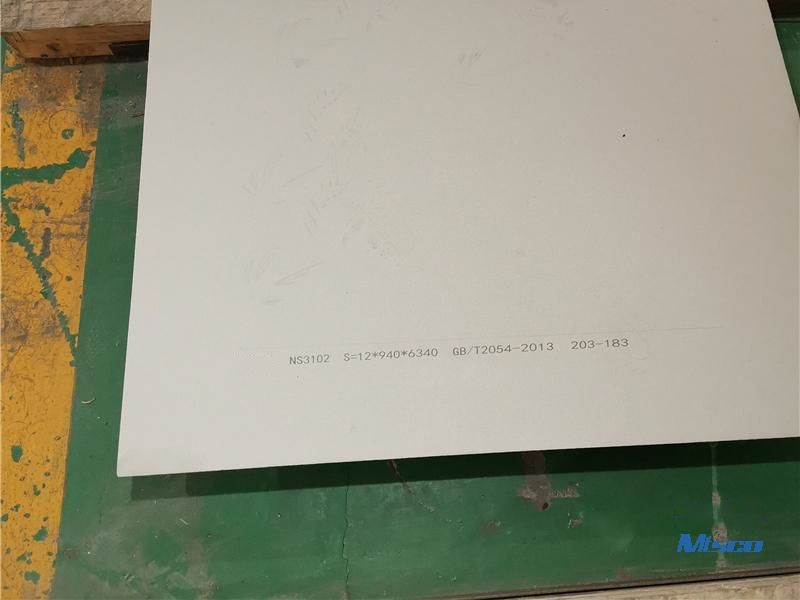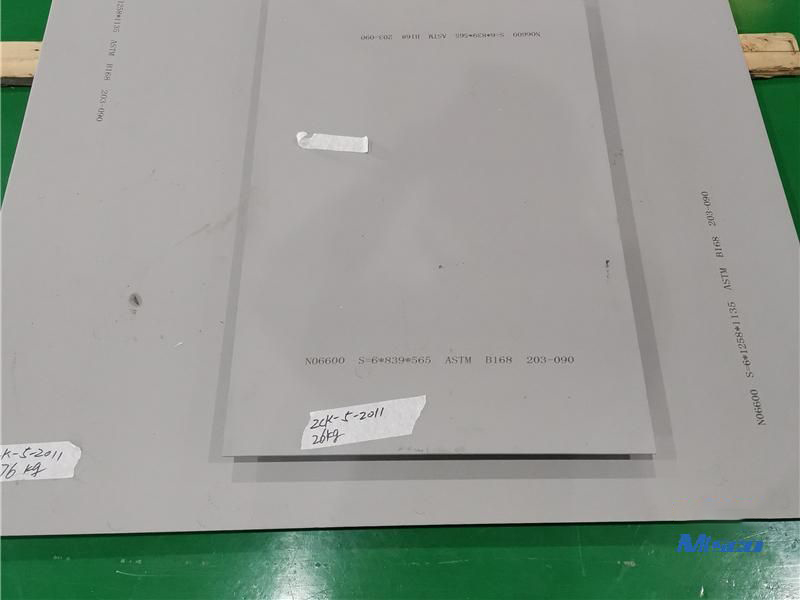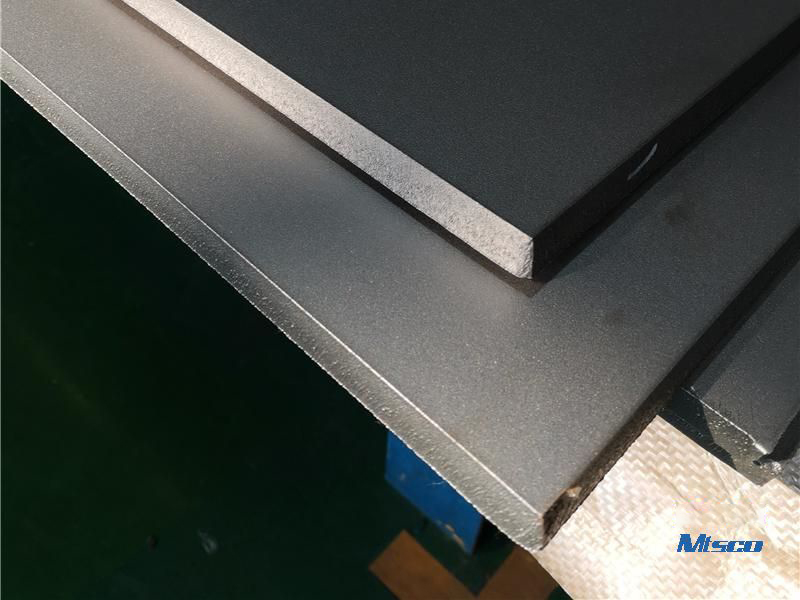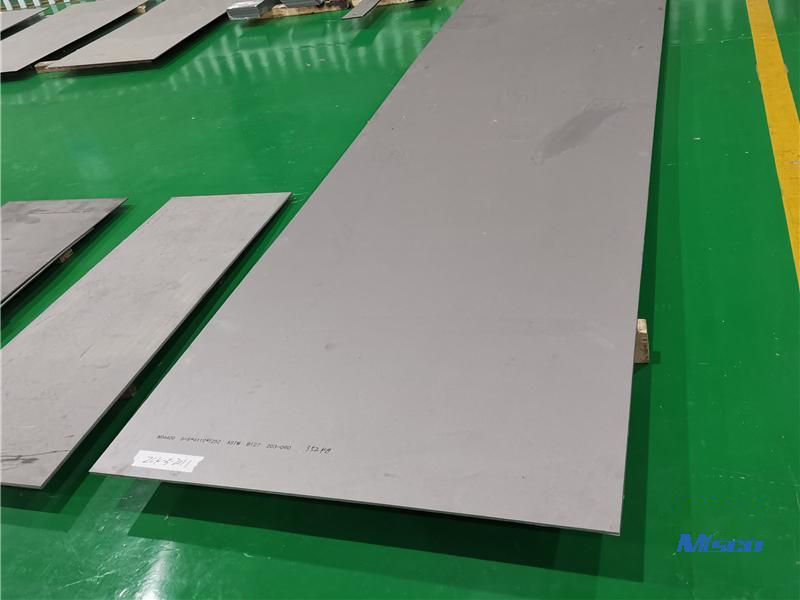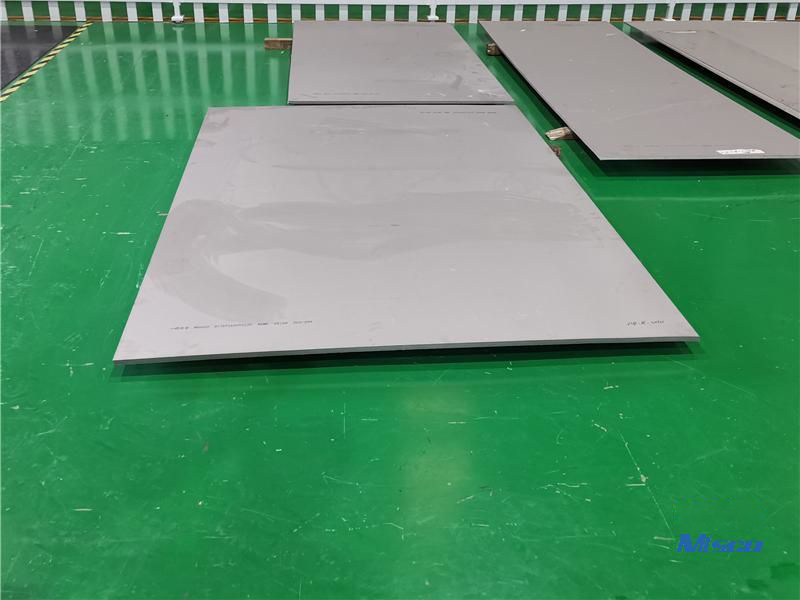Nickel alloy sheet - Mtsco
MTSCO stands at the forefront of innovation and quality in the manufacturing of nickel alloy sheet products. As a factory complex under the umbrella of MT Holding Group, MTSCO leverages cutting-edge technology and unparalleled expertise to produce superior nickel alloy plate and nickel alloy strip. Our commitment to excellence is reflected in our rigorous R&D and smelting processes, specially designed for challenging environments characterized by strong acid, high corrosion, and extreme temperatures and pressures.
Covering an expansive area of over 33,500 square meters, our state-of-the-art facilities are equipped with imported vacuum induction furnaces, electroslag remelting furnaces, air hammers, cold rolling and cold drawing machines, and environmentally advanced bright annealing furnaces. This robust infrastructure enables us to achieve an annual output of up to 3,000 tons of high-nickel alloy seamless pipes, catering to more than 25 countries and regions including Europe, South Korea, Russia, and the Middle East.
Our product line, which includes ASTM B480 High Quality Nickel Alloy 800/800H/800HT Cold Rolled Sheet/ Strip, demonstrates our advanced materials technology and efficiency. We also offer Nickel Alloy 600 /UNS N06600 ASTM B168 Cold Rolled Sheet/ Plate, meeting stringent ISO/PED certification standards, and ASTM B424/B906 Nickel Alloy 825 /UNS N08825 Sheet/ Plate/ Strip, renowned for its resistance to various corrosive environments. At MTSCO, we constantly enhance our quality inspection processes and employ digital, networked control systems to ensure every product's traceability from inception to delivery. Through relentless innovation and quality, MTSCO continues to serve global industries, providing optimal solutions with our high-grade nickel alloy products.
Covering an expansive area of over 33,500 square meters, our state-of-the-art facilities are equipped with imported vacuum induction furnaces, electroslag remelting furnaces, air hammers, cold rolling and cold drawing machines, and environmentally advanced bright annealing furnaces. This robust infrastructure enables us to achieve an annual output of up to 3,000 tons of high-nickel alloy seamless pipes, catering to more than 25 countries and regions including Europe, South Korea, Russia, and the Middle East.
Our product line, which includes ASTM B480 High Quality Nickel Alloy 800/800H/800HT Cold Rolled Sheet/ Strip, demonstrates our advanced materials technology and efficiency. We also offer Nickel Alloy 600 /UNS N06600 ASTM B168 Cold Rolled Sheet/ Plate, meeting stringent ISO/PED certification standards, and ASTM B424/B906 Nickel Alloy 825 /UNS N08825 Sheet/ Plate/ Strip, renowned for its resistance to various corrosive environments. At MTSCO, we constantly enhance our quality inspection processes and employ digital, networked control systems to ensure every product's traceability from inception to delivery. Through relentless innovation and quality, MTSCO continues to serve global industries, providing optimal solutions with our high-grade nickel alloy products.
Nickel Alloy Sheet/Strip
Nickel Alloy Sheet/Strip FAQ
Is nickel alloy better than stainless steel?▾
When comparing nickel alloys to stainless steel, several critical factors emerge that highlight the strengths and potential limitations of each material. The most notable differentiators include chemical composition, operating temperature, mechanical properties, application fields, and cost considerations. Understanding these aspects can help in determining whether nickel alloy is superior to stainless steel for specific applications.
Nickel alloys and stainless steel both offer substantial corrosion resistance, but their chemical compositions significantly differ. Stainless steel is primarily an iron alloy with a chromium content of about 20%, contributing to its corrosion-resistant properties. In contrast, nickel alloys have a higher nickel content, often exceeding 30%, and contain more molybdenum, enhancing their resistance to reduction corrosion. This composition makes nickel alloys generally more suited to withstand complex and highly corrosive environments than stainless steel.
Operating temperature is another critical parameter where nickel alloys outperform stainless steel. Stainless steel is predominantly utilized in normal temperature conditions. At elevated temperatures, its iron content struggles to maintain structural stability. On the other hand, nickel, being the primary component of nickel alloys, supports a stable austenitic structure even at high temperatures. Nickel alloys such as certain high-performance grades can maintain excellent mechanical properties and structural integrity in extreme heat, making them indispensable in aerospace, power generation, and other high-temperature industrial applications.
The mechanical properties of nickel alloys versus stainless steel are nuanced. While both materials can exhibit high strength, nickel alloys often have higher baseline strength due to the presence of more solid solution elements. This strength is retained across a broader range of temperatures compared to stainless steel. Though some types of stainless steel, such as martensitic stainless steel, can achieve high strength through quenching, this strength is generally effective only at room temperature. This limitation confines its use in environments where high-temperature performance is crucial.
The applications of stainless steel and nickel alloys overlap but also show distinct differences. Stainless steel finds extensive use in civilian sectors, including medical devices, construction, and household items, due to its balance of performance and cost. However, its suitability diminishes in high-temperature and highly corrosive environments. Nickel alloys are predominantly used in industrial and military settings. Fields requiring excellent performance in harsh conditions, such as chemical processing, power generation, and aerospace, largely depend on nickel alloys.
One must also consider economic factors when evaluating whether nickel alloy is better than stainless steel. Nickel alloys are generally more expensive due to their higher nickel and molybdenum content. Production costs are further elevated by the increased complexity of processing nickel alloys. This higher price point is justified by their superior performance in demanding applications. However, for applications that do not necessitate such high levels of performance, stainless steel remains a cost-effective and reliable choice.
In summary, while both stainless steel and nickel alloys are valuable materials with excellent corrosion resistance, nickel alloys are often superior in high-temperature conditions and complex corrosive environments. Their enhanced mechanical properties and stability at elevated temperatures make them indispensable in certain industrial and military applications. However, the higher cost of nickel alloys means that their use should be justified by the specific demands of the application. Ultimately, the choice between nickel alloys and stainless steel should be guided by the operational requirements and budget considerations of the project.
For those looking to source high-quality nickel alloy sheets, choosing a reliable manufacturer with extensive expertise in producing high-temperature and corrosion-resistant materials is crucial. Contact a reputable nickel alloy sheet manufacturer to discuss your specific needs and to obtain materials that meet the highest standards of performance and reliability.
● Chemical Composition and Corrosion Resistance
Nickel alloys and stainless steel both offer substantial corrosion resistance, but their chemical compositions significantly differ. Stainless steel is primarily an iron alloy with a chromium content of about 20%, contributing to its corrosion-resistant properties. In contrast, nickel alloys have a higher nickel content, often exceeding 30%, and contain more molybdenum, enhancing their resistance to reduction corrosion. This composition makes nickel alloys generally more suited to withstand complex and highly corrosive environments than stainless steel.
● High-Temperature Performance
Operating temperature is another critical parameter where nickel alloys outperform stainless steel. Stainless steel is predominantly utilized in normal temperature conditions. At elevated temperatures, its iron content struggles to maintain structural stability. On the other hand, nickel, being the primary component of nickel alloys, supports a stable austenitic structure even at high temperatures. Nickel alloys such as certain high-performance grades can maintain excellent mechanical properties and structural integrity in extreme heat, making them indispensable in aerospace, power generation, and other high-temperature industrial applications.
● Mechanical Properties
The mechanical properties of nickel alloys versus stainless steel are nuanced. While both materials can exhibit high strength, nickel alloys often have higher baseline strength due to the presence of more solid solution elements. This strength is retained across a broader range of temperatures compared to stainless steel. Though some types of stainless steel, such as martensitic stainless steel, can achieve high strength through quenching, this strength is generally effective only at room temperature. This limitation confines its use in environments where high-temperature performance is crucial.
● Application Fields
The applications of stainless steel and nickel alloys overlap but also show distinct differences. Stainless steel finds extensive use in civilian sectors, including medical devices, construction, and household items, due to its balance of performance and cost. However, its suitability diminishes in high-temperature and highly corrosive environments. Nickel alloys are predominantly used in industrial and military settings. Fields requiring excellent performance in harsh conditions, such as chemical processing, power generation, and aerospace, largely depend on nickel alloys.
● Cost Considerations
One must also consider economic factors when evaluating whether nickel alloy is better than stainless steel. Nickel alloys are generally more expensive due to their higher nickel and molybdenum content. Production costs are further elevated by the increased complexity of processing nickel alloys. This higher price point is justified by their superior performance in demanding applications. However, for applications that do not necessitate such high levels of performance, stainless steel remains a cost-effective and reliable choice.
● Conclusion
In summary, while both stainless steel and nickel alloys are valuable materials with excellent corrosion resistance, nickel alloys are often superior in high-temperature conditions and complex corrosive environments. Their enhanced mechanical properties and stability at elevated temperatures make them indispensable in certain industrial and military applications. However, the higher cost of nickel alloys means that their use should be justified by the specific demands of the application. Ultimately, the choice between nickel alloys and stainless steel should be guided by the operational requirements and budget considerations of the project.
For those looking to source high-quality nickel alloy sheets, choosing a reliable manufacturer with extensive expertise in producing high-temperature and corrosion-resistant materials is crucial. Contact a reputable nickel alloy sheet manufacturer to discuss your specific needs and to obtain materials that meet the highest standards of performance and reliability.
What is nickel alloy good for?▾
Nickel alloys, celebrated for their versatile applications and unique properties, are integral to a multitude of industries. Comprising combinations of nickel with elements such as chromium, iron, molybdenum, and copper, these alloys manifest exceptional characteristics that meet the demands of various high-performance applications.
Key Properties and Benefits of Nickel Alloys
Nickel alloys are distinguished by their excellent resistance to corrosion and high-temperature scaling, which are crucial in harsh environments. This resistance is pivotal in industries like chemical processing, where materials are constantly exposed to aggressive chemicals. Additionally, these alloys exhibit remarkable high-temperature strength, making them indispensable in applications requiring sustained mechanical performance at elevated temperatures.
One of the most intriguing properties of certain nickel alloys is their shape memory and low coefficient of expansion. For instance, nickel-titanium alloys, known for their shape-memory capabilities, are widely used in medical devices due to their ability to regain their original form after deformation. This unique behavior is harnessed in specialized connectors and other applications requiring precise, repeatable movements.
Diverse Types of Nickel Alloys and Their Applications
Each type of nickel alloy is tailored to specific applications, providing benefits that are unmatched by other materials. Here are some notable types and their uses:
*Wrought Nickel*: Pure nickel is prized in the chemical industry for its corrosion resistance, particularly against alkalis. It also finds applications in shielding against electromagnetic interference and in transducers.
*Nickel-Iron Alloys*: These alloys are essential as soft magnetic materials, glass-to-metal seals, and materials with defined thermal expansion properties. The low thermal expansion of specific nickel-iron alloys makes them invaluable in precision measuring instruments and thermostat rods, especially at cryogenic temperatures.
*Nickel-Copper Alloys*: Renowned for their resistance to corrosion by alkaline solutions, non-oxidizing salts, and seawater, these alloys are indispensable in marine and chemical processing environments.
*Nickel-Molybdenum Alloys*: These alloys exhibit high resistance to reducing acids, thriving in environments devoid of oxidizing ions like ferric and cupric ions. They perform exceptionally in highly corrosive settings, ensuring longevity and reliability.
*Nickel-Chromium Alloys*: Known for their superior resistance to both normal and high-temperature corrosion, these alloys are categorized based on their applications. They are crucial in heating elements, providing good corrosion resistance and high-temperature strength, and can be age-hardened for enhanced performance.
*Nickel-Chromium-Iron Alloys*: These alloys are celebrated for their strength at high temperatures and their ability to withstand oxidation, carburization, and other forms of high-temperature corrosion. They are widely utilized in applications requiring materials that can endure extreme thermal conditions.
*Nickel-Chromium-Molybdenum Alloys*: Exhibiting exceptional corrosion resistance, these alloys are ideal for handling reducing acids like hydrochloric and sulphuric acids. Variants of these alloys extend their resistance to more oxidizing or reducing conditions, ensuring their applicability in complex chemical environments.
*Nickel-Chromium-Cobalt Alloys*: The addition of cobalt and molybdenum provides these alloys with solid-solution strengthening and high levels of creep-rupture strength. They demonstrate outstanding resistance to high-temperature corrosion, including attacks by sulphidation and chlorides in both reducing and oxidizing atmospheres.
*Nickel-Titanium Alloys*: The shape-memory and super-elastic properties of these alloys are leveraged in medical devices and specialized applications. Their ability to undergo significant elastic deformation and return to their original shape makes them suitable for innovative uses such as spectacle frames and earthquake-resistant components in historic buildings.
Conclusion
In summary, nickel alloys bring unparalleled advantages to various sectors, from chemical processing and healthcare to energy and construction. Their unique combination of properties, including corrosion resistance, high-temperature strength, and specialized behaviors like shape memory, ensures their continued indispensability. The ongoing development and refinement of nickel alloys promise to meet future challenges, supporting technological advancements and contributing significantly to industrial innovations.
Key Properties and Benefits of Nickel Alloys
Nickel alloys are distinguished by their excellent resistance to corrosion and high-temperature scaling, which are crucial in harsh environments. This resistance is pivotal in industries like chemical processing, where materials are constantly exposed to aggressive chemicals. Additionally, these alloys exhibit remarkable high-temperature strength, making them indispensable in applications requiring sustained mechanical performance at elevated temperatures.
One of the most intriguing properties of certain nickel alloys is their shape memory and low coefficient of expansion. For instance, nickel-titanium alloys, known for their shape-memory capabilities, are widely used in medical devices due to their ability to regain their original form after deformation. This unique behavior is harnessed in specialized connectors and other applications requiring precise, repeatable movements.
Diverse Types of Nickel Alloys and Their Applications
Each type of nickel alloy is tailored to specific applications, providing benefits that are unmatched by other materials. Here are some notable types and their uses:
*Wrought Nickel*: Pure nickel is prized in the chemical industry for its corrosion resistance, particularly against alkalis. It also finds applications in shielding against electromagnetic interference and in transducers.
*Nickel-Iron Alloys*: These alloys are essential as soft magnetic materials, glass-to-metal seals, and materials with defined thermal expansion properties. The low thermal expansion of specific nickel-iron alloys makes them invaluable in precision measuring instruments and thermostat rods, especially at cryogenic temperatures.
*Nickel-Copper Alloys*: Renowned for their resistance to corrosion by alkaline solutions, non-oxidizing salts, and seawater, these alloys are indispensable in marine and chemical processing environments.
*Nickel-Molybdenum Alloys*: These alloys exhibit high resistance to reducing acids, thriving in environments devoid of oxidizing ions like ferric and cupric ions. They perform exceptionally in highly corrosive settings, ensuring longevity and reliability.
*Nickel-Chromium Alloys*: Known for their superior resistance to both normal and high-temperature corrosion, these alloys are categorized based on their applications. They are crucial in heating elements, providing good corrosion resistance and high-temperature strength, and can be age-hardened for enhanced performance.
*Nickel-Chromium-Iron Alloys*: These alloys are celebrated for their strength at high temperatures and their ability to withstand oxidation, carburization, and other forms of high-temperature corrosion. They are widely utilized in applications requiring materials that can endure extreme thermal conditions.
*Nickel-Chromium-Molybdenum Alloys*: Exhibiting exceptional corrosion resistance, these alloys are ideal for handling reducing acids like hydrochloric and sulphuric acids. Variants of these alloys extend their resistance to more oxidizing or reducing conditions, ensuring their applicability in complex chemical environments.
*Nickel-Chromium-Cobalt Alloys*: The addition of cobalt and molybdenum provides these alloys with solid-solution strengthening and high levels of creep-rupture strength. They demonstrate outstanding resistance to high-temperature corrosion, including attacks by sulphidation and chlorides in both reducing and oxidizing atmospheres.
*Nickel-Titanium Alloys*: The shape-memory and super-elastic properties of these alloys are leveraged in medical devices and specialized applications. Their ability to undergo significant elastic deformation and return to their original shape makes them suitable for innovative uses such as spectacle frames and earthquake-resistant components in historic buildings.
Conclusion
In summary, nickel alloys bring unparalleled advantages to various sectors, from chemical processing and healthcare to energy and construction. Their unique combination of properties, including corrosion resistance, high-temperature strength, and specialized behaviors like shape memory, ensures their continued indispensability. The ongoing development and refinement of nickel alloys promise to meet future challenges, supporting technological advancements and contributing significantly to industrial innovations.
How durable is nickel alloy?▾
Nickel alloys stand out as a superior choice for applications requiring exceptional durability in extreme conditions. Their unique properties make them indispensable across various industries, including aerospace, automotive, chemical processing, marine, mining, and power generation. The core element in these alloys is nickel, a metal known for its exceptional resistance to corrosion, oxidation, and high temperatures, which are crucial in maintaining long-term structural integrity and performance.
One of the most compelling attributes of nickel alloys is their ability to maintain strength and ductility over a wide range of temperatures. Unlike many other materials, nickel alloys do not become brittle when worked, even under extreme thermal stress. This makes them a reliable choice for components subjected to high temperatures and cyclic loading. In environments where other metals might fail due to stress cracking or deformation, nickel alloys continue to perform robustly, ensuring safety and longevity.
The high ductility of nickel alloys also contributes to their ease of fabrication. Metals such as copper offer excellent ductility but lack the high-temperature strength needed for critical applications. Conversely, materials like iron are strong but can become brittle under similar conditions. Nickel alloys combine the best of both worlds, offering a balanced mix of high strength, corrosion resistance, and workability. This unique combination significantly reduces the risk of sudden component failure, which can be hazardous in high-stress environments.
The versatility of nickel alloys extends to their compositional flexibility. They can be combined with various other metals to enhance specific properties. For instance, the addition of titanium increases both strength and corrosion resistance at high temperatures, making the alloy suitable for aerospace applications. Copper enhances machinability and electrical conduction, which is beneficial in the electronics industry. Cobalt improves corrosion resistance in extremely hot conditions, while chromium adds resistance to stress-cracking. Aluminum and niobium, on the other hand, enhance strength and weldability, respectively. This adaptability allows for the creation of specialized alloys tailored to meet the demands of specific applications, further underscoring their durability.
Nickel alloys are not just strong and versatile; they are also incredibly durable. A typical nickel alloy component can last between 25 to 35 years or even longer, depending on the conditions. This long operative life is particularly noteworthy in industries where material failure can lead to catastrophic consequences. For instance, in the oil and gas sector, where components are exposed to extreme pressures and corrosive environments, the longevity and reliability of nickel alloys are invaluable.
The ability to withstand high temperatures without loss of strength or ductility is another critical factor contributing to the durability of nickel alloys. They remain stable and perform well in both cryogenic and extremely hot environments. This makes them an excellent choice for thermal processing applications and high-stress conditions found in power generation and petrochemical industries.
In summary, the durability of nickel alloys is unmatched, making them a preferred choice for high-stress, critical applications across various industries. Their unique combination of strength, ductility, and resistance to corrosion and high temperatures ensures a long operative life, significantly reducing the risk of component failure. The versatility in their composition allows for the creation of specialized alloys tailored to specific needs, further enhancing their durability and reliability. Whether in aerospace, automotive, marine, or power generation, nickel alloys continue to prove their worth, maintaining performance and safety even in the harshest conditions.
● Key Characteristics of Nickel Alloys
One of the most compelling attributes of nickel alloys is their ability to maintain strength and ductility over a wide range of temperatures. Unlike many other materials, nickel alloys do not become brittle when worked, even under extreme thermal stress. This makes them a reliable choice for components subjected to high temperatures and cyclic loading. In environments where other metals might fail due to stress cracking or deformation, nickel alloys continue to perform robustly, ensuring safety and longevity.
The high ductility of nickel alloys also contributes to their ease of fabrication. Metals such as copper offer excellent ductility but lack the high-temperature strength needed for critical applications. Conversely, materials like iron are strong but can become brittle under similar conditions. Nickel alloys combine the best of both worlds, offering a balanced mix of high strength, corrosion resistance, and workability. This unique combination significantly reduces the risk of sudden component failure, which can be hazardous in high-stress environments.
● Versatility in Composition
The versatility of nickel alloys extends to their compositional flexibility. They can be combined with various other metals to enhance specific properties. For instance, the addition of titanium increases both strength and corrosion resistance at high temperatures, making the alloy suitable for aerospace applications. Copper enhances machinability and electrical conduction, which is beneficial in the electronics industry. Cobalt improves corrosion resistance in extremely hot conditions, while chromium adds resistance to stress-cracking. Aluminum and niobium, on the other hand, enhance strength and weldability, respectively. This adaptability allows for the creation of specialized alloys tailored to meet the demands of specific applications, further underscoring their durability.
● Longevity and Reliability
Nickel alloys are not just strong and versatile; they are also incredibly durable. A typical nickel alloy component can last between 25 to 35 years or even longer, depending on the conditions. This long operative life is particularly noteworthy in industries where material failure can lead to catastrophic consequences. For instance, in the oil and gas sector, where components are exposed to extreme pressures and corrosive environments, the longevity and reliability of nickel alloys are invaluable.
The ability to withstand high temperatures without loss of strength or ductility is another critical factor contributing to the durability of nickel alloys. They remain stable and perform well in both cryogenic and extremely hot environments. This makes them an excellent choice for thermal processing applications and high-stress conditions found in power generation and petrochemical industries.
● Conclusion
In summary, the durability of nickel alloys is unmatched, making them a preferred choice for high-stress, critical applications across various industries. Their unique combination of strength, ductility, and resistance to corrosion and high temperatures ensures a long operative life, significantly reducing the risk of component failure. The versatility in their composition allows for the creation of specialized alloys tailored to specific needs, further enhancing their durability and reliability. Whether in aerospace, automotive, marine, or power generation, nickel alloys continue to prove their worth, maintaining performance and safety even in the harshest conditions.
Is nickel alloy stronger than steel?▾
When comparing the strength of nickel alloy and steel, various factors such as chemical composition, operating temperature, mechanical properties, and application fields come into play. Both materials are renowned for their corrosion resistance and versatility in industrial applications, but nickel alloys often exhibit superior performance in specific conditions. This analysis delves into the attributes that contribute to the strength and practicality of these two materials.
The fundamental difference between stainless steel and nickel alloy is their chemical composition. Stainless steel is primarily an iron alloy with a chromium content of about 20% to enhance corrosion resistance. Nickel alloy, on the other hand, has a higher nickel content, sometimes exceeding 70%, and typically includes substantial amounts of molybdenum. This high nickel and molybdenum content significantly improves the material's overall resistance to various forms of corrosion, particularly in complex and harsh environments. This enhanced corrosion resistance translates into less material degradation and longer lifespan under such conditions, which can be a crucial factor in evaluating the overall "strength" and reliability of the alloy.
Nickel alloys are distinctly advantageous in high-temperature applications, unlike stainless steel, which is generally used at normal temperatures. The ability of nickel to maintain its structural integrity at elevated temperatures allows nickel alloys to sustain their austenitic structure under extreme conditions. This characteristic makes nickel alloys indispensable in industries where high temperature resistance is paramount, such as aerospace and power generation.
In terms of mechanical properties, the strength comparison between nickel alloys and stainless steel is multifaceted. While both materials offer a range of high-strength and low-strength options, nickel alloys typically exhibit higher strength due to the presence of more solid solution elements. This inherent strength is particularly pronounced at high temperatures, where nickel alloys maintain their mechanical properties better than austenitic stainless steels. Martensitic stainless steel can be strengthened through quenching, achieving high strength at room temperature; however, this process often compromises corrosion resistance.
Stainless steel and nickel alloys share a significant overlap in their application fields due to their corrosion-resistant properties. However, the two materials diverge in certain specialized uses. Stainless steel is prevalent in civilian applications, including medical tools, construction materials, and household items. In contrast, nickel alloys are predominantly utilized in industrial and military settings, where high temperature performance and exceptional corrosion resistance are crucial. This distinction underscores the practical considerations companies must weigh when choosing between these materials.
The financial aspect also plays a critical role in the selection of materials. Nickel alloys are significantly more expensive than stainless steel, driven by the higher cost of nickel and molybdenum compared to iron. Additionally, the greater complexity in processing nickel alloys, due to their superior strength and stringent control of trace elements, increases manufacturing costs. While the higher price point of nickel alloys can be a limiting factor, their enhanced performance and durability in specialized environments often justify the investment.
In summary, while both stainless steel and nickel alloy offer robust solutions for corrosion resistance, nickel alloys generally provide superior strength, especially at high temperatures and in complex corrosive environments. The choice between these materials depends on specific application requirements, including operating conditions and budget constraints. Nickel alloys, with their exceptional mechanical properties and resilience, present a compelling option for demanding industrial and military applications, whereas stainless steel remains a versatile and cost-effective choice for a wide range of civilian uses.
● Chemical Composition and Corrosion Resistance
The fundamental difference between stainless steel and nickel alloy is their chemical composition. Stainless steel is primarily an iron alloy with a chromium content of about 20% to enhance corrosion resistance. Nickel alloy, on the other hand, has a higher nickel content, sometimes exceeding 70%, and typically includes substantial amounts of molybdenum. This high nickel and molybdenum content significantly improves the material's overall resistance to various forms of corrosion, particularly in complex and harsh environments. This enhanced corrosion resistance translates into less material degradation and longer lifespan under such conditions, which can be a crucial factor in evaluating the overall "strength" and reliability of the alloy.
● Operating Temperature and Mechanical Properties
Nickel alloys are distinctly advantageous in high-temperature applications, unlike stainless steel, which is generally used at normal temperatures. The ability of nickel to maintain its structural integrity at elevated temperatures allows nickel alloys to sustain their austenitic structure under extreme conditions. This characteristic makes nickel alloys indispensable in industries where high temperature resistance is paramount, such as aerospace and power generation.
In terms of mechanical properties, the strength comparison between nickel alloys and stainless steel is multifaceted. While both materials offer a range of high-strength and low-strength options, nickel alloys typically exhibit higher strength due to the presence of more solid solution elements. This inherent strength is particularly pronounced at high temperatures, where nickel alloys maintain their mechanical properties better than austenitic stainless steels. Martensitic stainless steel can be strengthened through quenching, achieving high strength at room temperature; however, this process often compromises corrosion resistance.
● Application Fields
Stainless steel and nickel alloys share a significant overlap in their application fields due to their corrosion-resistant properties. However, the two materials diverge in certain specialized uses. Stainless steel is prevalent in civilian applications, including medical tools, construction materials, and household items. In contrast, nickel alloys are predominantly utilized in industrial and military settings, where high temperature performance and exceptional corrosion resistance are crucial. This distinction underscores the practical considerations companies must weigh when choosing between these materials.
● Cost Considerations
The financial aspect also plays a critical role in the selection of materials. Nickel alloys are significantly more expensive than stainless steel, driven by the higher cost of nickel and molybdenum compared to iron. Additionally, the greater complexity in processing nickel alloys, due to their superior strength and stringent control of trace elements, increases manufacturing costs. While the higher price point of nickel alloys can be a limiting factor, their enhanced performance and durability in specialized environments often justify the investment.
● Conclusion
In summary, while both stainless steel and nickel alloy offer robust solutions for corrosion resistance, nickel alloys generally provide superior strength, especially at high temperatures and in complex corrosive environments. The choice between these materials depends on specific application requirements, including operating conditions and budget constraints. Nickel alloys, with their exceptional mechanical properties and resilience, present a compelling option for demanding industrial and military applications, whereas stainless steel remains a versatile and cost-effective choice for a wide range of civilian uses.


